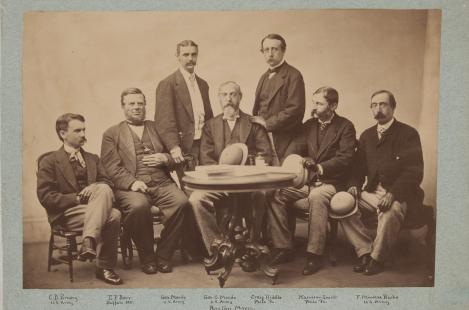The Museum’s History
The Civil War Museum of Philadelphia was chartered in 1888, but the Museum’s history and its collection had their beginnings as the Civil War ended in 1865. A group of Union officers in Philadelphia came together after the assassination of Abraham Lincoln, fearing that the War might start again. When that concern was allayed, theseofficers served as the honor guard for President Lincoln’s body as it lay in state in Independence Hall. They soon determined that they could commemorate the sacrifices and service of Union officers by forming an organization, the Military Order of the Loyal Legion of the United States [MOLLUS] [loyallegionpa.org/about/]. With headquarters in Philadelphia, “commanderies” were established in the states that supported the Union during the War.
The collection was created, for the most part, as a result of contributions of MOLLUS members, their families, and the leading citizens of the time. President Rutherford B. Hayes was the first President of what was then called the War Library and Museum. This provenance means that the personal stories, as well as, the war stories of these men can be told through the uniforms, diaries, weapons and other belongings in the collection. A bullet-struck pocket watch and bloody handkerchief tell as powerful a tale of the experience of battle, as the rifle and bayonet; a scrapbook with a letter from home and a lock of hair, as meaningful as a flag tattered by battle.
The Museum was housed at 18th and Pine Streets in Philadelphia from 1922 until 2008, when it closed in anticipation of building a new museum in Philadelphia. Since 2010 the collection has been cared for by the Gettysburg Foundation and stored at the Gettysburg Battlefield Museum and Visitors Center, where artifacts have been exhibited in the main galleries and in the special exhibition for the 150th anniversary of the Battle of Gettysburg from 2013-2015.
Plans for a New Museum
History is measured in moments, but made by people. And not just “great” people, but ordinary ones, who often accomplish extraordinary things and, through their actions, become agents of change. The collection of the Civil War Museum of Philadelphia enables us today to encounter some of these individuals, be inspired by their experiences, and come away better informed with new and broader understandings of the Civil War and America in the 19th century.
The Board of the Museum planned to build a new museum to house the collection in Philadelphia which, although not the scene of any battle, played a key role in the Civil War. Philadelphia, was the second largest city in the country and was not only the place where the nation’s founding charters took shape, but also where the largest free black community in America established institutions and took a leadership role in the abolition movement; where over a $1 billion in bonds were sold to finance the Civil War; and where the issues of slavery and national unity were sharply focused in political dialogue, in the press, and on the streets.
Philadelphia, often called the “southernmost Northern city”, had close economic and familial ties to the South and much of its wealth came from the textile industry and trade with the South. Philadelphians owned plantations and the largest slave holder in the country, Peirce Butler, was a leading citizen. Philadelphia played a key role in all aspects of the struggle that split our nation in two and threatened the Union and the values and beliefs that inspired it.
After much consideration of changed circumstances in the region’s philanthropic environment, the Board of Governors determined that it needed to seek a new strategy that could ensure that the collection would be preserved and kept intact in perpetuity, be cared for at the highest standards, and be accessible to the public. Rather than continuing to pursue the goal of building a new museum, a plan was developed to transfer the collection to the Gettysburg Foundation where it will be part of the extraordinary collection in the Gettysburg Museum and Visitors Center and in the iconic setting of the Gettysburg National Military Park. In addition, by establishing a partnership between the Gettysburg Foundation and the National Constitution Center, the Board ensured that a significant portion of the collection will be exhibited in Philadelphia.
